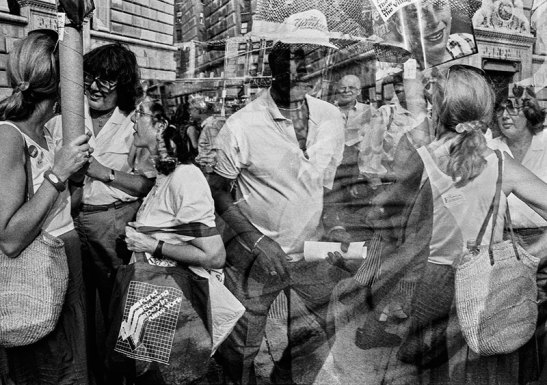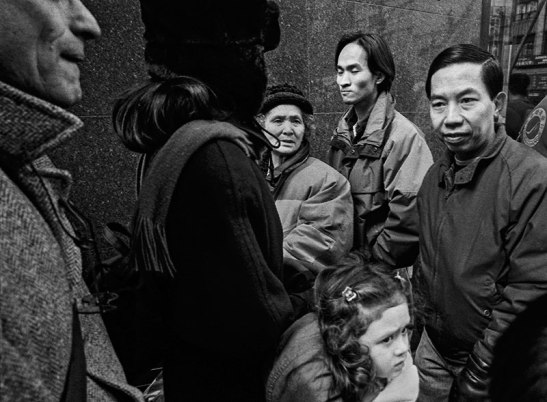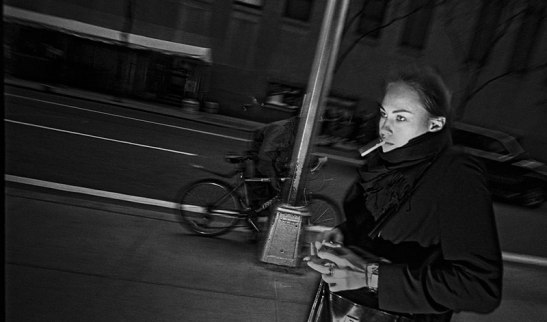Faces in the Crowd
A friend, visiting from California recently, remarked that New Yorkers are skilled in the “art of the swerve.” She was referring to that moment that happens when two people, approaching each other on the sidewalk, manage to dodge at the last second and avoid colliding. “How do you know which way to move?” she asked in wonder. All I could say is that it’s an instinct you develop pretty quickly when living here.

© Harvey Stein 2015
It makes sense, then, to read in the introduction to Harvey Stein’s Briefly Seen: New York Street Life that New York has 27,000 residents per square mile, the highest population density of any American city. Moreover, many people live in such small spaces that “the urban dance is… frenzied.” Behavior is often uninhibited, tempers can run short, and “streets become the city’s living room.”

© Harvey Stein 2015
Of course, that makes it a great place for street photography. So does the city’s talent for pulling in eccentric characters, its ethnic diversity, and its extremes of wealth and poverty. Appropriately, too, New York street photography is itself very diverse—even when it focuses on people. I can’t, for instance, think of two more different projects than Brandon Stanton’s colorful, generally upbeat (and somewhat criticized) Humans of New York, and Stein’s moody, lush, impressionistic Briefly Seen.

An exercise in contrasts: Harvey Stein’s Briefly Seen: New York Street Life and Brandon Stanton’s Humans of New York
A quintessential street photographer, Stein (who was once my teacher) has been patrolling the streets of New York for over four decades, his two Leica cameras in hand. Unassuming but persistent, he likes to get close to his subjects, preferring them to be aware of his presence. “I enjoy crowds and, when photographing, I often become part of the crowd,” he writes.
Briefly Seen is the third in a trilogy of books Stein has recently put out about New York, following on from 2011’s Coney Island 40 Years and 2013’s Harlem Street Portraits. Like its predecessors, the book contains photographs shot over the course of three decades or more. Because of Stein’s close-up approach and use of black and white, though, it’s hard to tell which images were shot in the 1980s and which were taken yesterday.

© Harvey Stein 2015
But Briefly Seen has a different flavor and mood from its two predecessors. Where Coney Island 40 Years was a joyous celebration of the raucous energy of Coney Island, and Harlem Street Portraits was a loving series of portraits of Harlem residents, the New York captured in Briefly Seen seems rougher, more anonymous. It is more the New York of Scorcese’s Taxi Driver than that of Woody Allen’s Manhattan.

© Harvey Stein 2015
To enhance the feeling of being in a busy metropolis, Stein uses blur, grain, low-angle flash, skewed perspectives, double exposures, tight cropping and wide angles. Lacking the context of captions, the scenes here swirl around, dream-like, freeing the viewer to experience them emotionally first and foremost. And the emotion skews to the melancholy. Some moments of tenderness are documented, but they take place within the context of a surging, indifferent crowd: on the whole, most people seem to be leading Thoreau’s “lives of quiet desperation.”

© Harvey Stein 2015
That feeling is enhanced by Stein’s tonal palette, which tends toward the dark and rarely makes it all the way to white. Stein cites Garry Winogrand and Diane Arbus as major influences, but some of these moody images brought to mind the great photographer Roy DeCarava, a master in the use of shadow and sultry, dark tones. In DeCarava’s case, the aesthetic was partly a political statement: as he told the New York Times in 1982, “I felt that black people were not being portrayed in a serious and in an artistic way.” For Stein, the darkness seems to be about conveying the tone of a city that he describes as often “too crowded, too oppressive, too hot and dirty.”

© Harvey Stein 2015
That said, there are also some moments of sublime charm here. I loved the portrait of a Charlie Chaplin impersonator standing quietly on the sidewalk as traffic rushes by, and the one of two elderly ladies in Easter bonnets. Stein’s New York is diverse both racially and economically: we see beggars and society folk (even Donald Trump makes an appearance at one point). Nor is Stein averse to the charms of a pretty woman: the book opens with a series of solitary young women, in each of whom beauty flares in the darkness like a struck match.

© Harvey Stein 2015
However, these solitary portraits are in the minority: much of the book is taken up with crowd scenes. At their best, these scenes are trenchantly observed and revealing in their details—such as the shot where a hunched-over beggar faces an indifferent surge of passersby. Some, however, get repetitive: the thoughtful individual in an anonymous crowd is a trope that this book uses pretty liberally.

© Harvey Stein 2015
Overall, though, Briefly Seen: New York Street Life comes across as a fond, admiring ode to New Yorkers’ and their indomitability. On balance, I’d say that I prefer the cleaner and tighter aesthetic of Coney Island 40 Years and Harlem Street Portraits, but I appreciate the mood summoned by Briefly Seen: New York Street Life, with its stubborn, chaotic in-your-faceness. It seems evocative of a pre-gentrified New York, the city of graffiti, garbage strikes, and Bonfire of the Vanities. If you’re nostalgic for that gritty city, this is the coffee table book for you.
4 comments on “Faces in the Crowd”
Leave a Reply
Connecting to %s


Very interesting and intriguing.
Sarah, Harvey Stein’s photographs are so arresting and ‘real’ that I began to get the illusion that they were posed, or at least set up.
Have you experienced this with Stein or another photographer?
Michael
Thanks, Michael. There are certainly photographers who stage images to look spontaneous, or who use Photoshop to alter spontaneously-captured images in various ways. (Check out this project: http://peterfunch.com/works/babeltales/) But as far as I know, Harvey Stein is an old-school, spontaneous street photographer.
Hi Sarah,
Enjoyed your review. No, like the politics we see this week, you can not make this up or stage it. I agree, the images are purely spontaneous. I have also taken a course with Harvey and have traveled with him on many workshops. Harvey has a curiosity about people that is fascinating to watch and very subtle. In Briefly Seen we see him go a step further. Not just a close up or portrait but also a dynamic of moving energy or tension that I find very compelling and unique. It is what most of us don’t see.
Bob
looks great …. can’t wait to see the whole thing